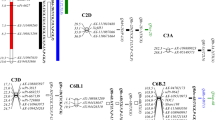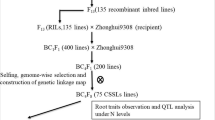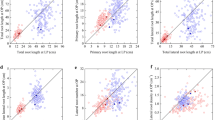Abstract
Improved root system architecture can enhance agronomic performance by increasing water and nitrogen (N) acquisition efficiency. However, little is known about interaction between root system architecture and agronomic performance under field environments. To gain a better understanding about the genetic basis of these relationships, we evaluated a set of chromosome segment substitution lines (CSSLs) derived from crosses between a tropical japonica rice cultivar ‘Curinga’ and a wild species Oryza rufipogon accession IRGC105491. Root system architectural traits were investigated using the CSSLs at 40 days old seedlings using the root basket method under hydroponic conditions, and agronomic performances were also tested under field conditions with different N treatments. Agronomic performances were computed as the ratio of a trait value under low to high N treatments, including grain yield and biomass yield as nitrogen-deficiency tolerance (NDT) traits. Root architecture and NDT trait QTLs were mapped using 238 SNP marker loci. A total of 13 QTLs for root system architectural, NDT and morpho-physiological traits were identified on chromosomes 1, 3, 4, 5, 7, 8, 9, 10 and 12. Interestingly, a QTL for deeper root number was identified the region of SNP markers between id1012330 and id1021697 on chromosome 1 under hydroponic conditions overlapped with a QTL for NDT trait of relative grain yield (qRGY1). These results suggest that deeper root trait is helpful to maintain grain yield under nitrogen-deficient conditions. The QTL associated root architecture could potentially be used in future rice-breeding efforts to increase agronomic performance under nitrogen-deficient conditions.

Similar content being viewed by others
Abbreviations
- ANOVA:
-
Analysis of variance
- ANUE:
-
Agronomic nitrogen use efficiency
- CIAT:
-
International center for tropical agriculture: spanish-language name centro internacional de agricultura tropical
- CSSL:
-
Chromosome segment substitution line
- DAT:
-
Day after transplant
- FP:
-
Farmer’s practice
- N:
-
Nitrogen
- NUE:
-
Nitrogen use efficiency
- NDT:
-
Nitrogen-deficiency tolerance
- QTL:
-
Quantitative trait locus
- RBM:
-
Relative biomass yield
- RDR:
-
Ratio of deeper root
- RGY:
-
Relative grain yield
- RPV:
-
Root pattern value
- RSA:
-
Root system architecture
- SNP:
-
Single nucleotide polymorphism
- SPAD:
-
Soil and plant analyzer development
References
Arai-Sanoh Y, Takai T, Yoshinaga S, Nakano H, Kojima M, Sakakibara H, Kondo M, Uga Y (2014) Deep rooting conferred by DEEPER ROOTING 1 enhances rice yield in paddy fields. Sci Rep 4:5563. doi:10.1038/srep05563
Araki R, Hasegawa H (2006) Expression of rice (Oryza sativa L.) genes involved in high-affinity nitrate transport during the period of nitrate induction. Breed Sci 56:295–302
Broadbent FE, De Datta SK, Laureles EV (1987) Measurement of nitrogen use efficiency in rice genotype. Agron J 79:786–791
Chapman N, Milleremail AJ, Lindsey K, Richard WW (2012) Roots, water, and nutrient acquisition: let’s get physical. Trend Plant Sci 17:701–710
Chin JH, Lu X, Haefele SM, Gamuyao R, Ismail A, Wissuwa M, Heuer S (2010) Development and application of gene-based markers for the major rice QTL Phosphorus uptake 1. Theor Appl Genet 120:1073–1086
Coque M, Martin A, Veyrierias JB, Hirel B, Gallais A (2008) Genetic variation of N-remobilization and post silking N-uptake in a set of maize recombinant inbred lines. 3. QTL detection and coincidences. Theor Appl Genet 117:729–747
Courtois B, Shen L, Petalcorin W, Carandang S, Mauleon R, Li Z (2003) Locating QTLs controlling constitutive root traits in the rice population IAC 165 × Co39. Euphytica 134:335–345
Craswell ET, Godwin DC (1984) The efficiency of nitrogen fertilizers applied to cereals in different climates. In: Tinker B, Launch A (eds) Advance in plant nutrition, vol 1. Preager, New York, pp 1–55
Dawson JC, Huggins DR, Jones AA (2008) Characterizing nitrogen use efficiency in natural and agricultural ecosystems to improve the performance of cereal crops in low-input and organic agricultural systems. Field Crops Res 107:89–101
De Datta SK, Broadbent FE (1990) Nitrogen N-use efficiency of 24 rice genotypes on N-deficient soil. Field Crops Res 23:81–92
de Dorlodot FB, Pages L, Price A, Tuberosa R, Draye X (2007) Root system architecture: opportunities and constraints for genetic improvement of crops. Trends Plant Sci 12:474–481
Dobermann A, Cassman KG (2005) Cereal area and nitrogen use efficiency are drivers of future nitrogen fertilizer consumption. Sci China Life Sci 48:745–758
Epstein E, Bloom AJ (2005) Mineral nutrition of plants: principles and perspectives, 2nd edn. Sinauer Associates, Sunderland
Feng H, Yan M, Fan X, Li B, Shen Q, Miller AJ, Xu G (2011) Spatial expression and regulation of rice high-affinity nitrate transporters by nitrogen and carbon status. J Exp Bot 62:2319–2332
Franca MGC, Rossiello ROP, Ramos FT, Zonta E (2006) Root growth and proton efflux rates of rice seedlings in a greenhouse environment. Acta Bot Bras 20:25–30
Fu Q, Zhang P, Tan L, Zhu Z, Ma D, Fu Y, Zhan X, Cai H, Sun C (2010) Analysis of QTLs for yield-related traits in Yuanjiang common wild rice (Oryza rufipogon Griff.). J Genet Genome 37:147–157
Garnett T, Conn V, Kaiser BN (2009) Root based approaches to improving nitrogen use efficiency in plants. Plant Cell Environ 32:1272–1283
Gewin V (2010) Food: an underground revolution. Nature 29:552–553
Gifford ML, Banta JA, Katari MS, Hulsmans J, Chen L, Ristova D, Tranchina D, Purugganan MD, Coruzzi GM, Birnbaum KD (2013) Plasticity regulators modulate specific root traits in discrete nitrogen environments. Bomblies K, ed. PLoS Genet 9(9):e1003760. doi:10.1371/journal.pgen.1003760
Katayama H, Mori M, Kawamura Y, Tanaka T, Mori M, Hasegawa H (2009) Production and characterization of transgenic plants carrying a high-affinity nitrate transporter gene (OsNRT2.1). Breed Sci 59:237–243
Kato Y, Abe J, Kamoshita A, Yamagishi J (2006) Genotypic variation in root growth angle in rice (Oryza sativa L.) and its association with deep root development in upland fields with different water regimes. Plant Soil 287:117–129
Lian X, Xing Y, Yan H, Xu C, Li X, Zhang Q (2005) QTLs for low nitrogen tolerance at seedling stage identified using a recombinant inbred line population derived from an elite rice hybrid. Theor Appl Genet 112:85–96
López-Bucio J, Cruz-Ramírez A, Herrera-Estrella L (2003) The role of nutrient availability in regulating root architecture. Curr Opin Plant Biol 6:280–287
Lorieux M (2005) CSSL Finder: a free program for managing introgression lines. http://mapdisto.free.fr/. Accessed 22 Mar 2016
Lynch JP (1998) The role of nutrient-efficient crops in modern agriculture. J Crop Prod 206:241–264
Lynch JP (2013) Steep, cheap and deep: an ideotype to optimize water and N acquisition by maize root systems. Ann Bot 112:347–357
Makino A (2003) Rubisco and nitrogen relationships in rice: leaf photosynthesis and plant growth. Soil Sci Plant Nutr 49:319–327
Mishra A, Uphoff N (2013) Morphological and physiological responses of rice roots and shoots to varying water regimes and soil microbial densities. Arch Agron Soil Sci 59:705–731
Moncada P, Martinez CP, Borrero J, Chatel M, Gauch H, Guimaraes E, Tohme J, McCouch SR (2001) Quantitative trait loci for yield and yield components in an Oryza sativa × Oryza rufipogon BC2F2 population evaluated in an upland environment. Theor Appl Genet 102:41–52
Obara M, Kajiura M, Fukuta Y, Yano M, Hayashi M, Yamaya T, Sato T (2001) Mapping of QTLs associated with cytosolic glutamine synthetase and NADH-glutamate synthase in rice (Oryza sativa L.). J Exp Bot 52:1209–1217
Obara M, Tamura W, Ebitani T, Yano M, Sato T, Yamaya T (2010) Fine-mapping of qRL6.1, a major QTL for root length of rice seedlings grown under a wide range of NH4 + concentrations in hydroponic conditions. Theor Appl Genet 121:535–547
Obara M, Takeda T, Hayakawa T, Yamaya T (2011) Mapping quantitative trait loci controlling root length in rice seedlings grown with low or sufficient supply using backcross recombinant lines derived from a cross between Oryza sativa L. and Oryza glaberrima Steud. Soil Sci Plant Nutr 57:80–92
Ogawa S, Valencia MO, Ishitani M, Selvaraj MG (2014a) Root system architecture variation in response to different NH4 + concentrations and its association with nitrogen-deficient tolerance traits in rice. Acta Physiol Plant 36:2361–2372
Ogawa S, Selvaraj MG, Fernando AJ, Lorieux M, Ishitani M, McCouch S, Arbelaez FD (2014b) N and P mediated seminal root elongation response in rice seedlings. Plant Soil 375:305–315
Oyanagi A, Nakamoto T, Wada M (1993) Relationship between root growth angle of seedlings and vertical distribution of roots in the field in wheat cultivars. Japan J Crop Sci 62:565–570
Peng SB, Buresh RJ, Huang JL, Yang JC, Zou YB, Zhong XH, Wang GH, Zhang FS (2006) Strategies for overcoming low agronomic nitrogen use efficiency in irrigated rice system in China. Field Crops Res 96:37–47
Postma JA, Schurr U, Fiorani F (2013) Dynamic root growth and architecture responses to limiting nutrient availability: linking physiological models and experimentation. Biotech Adv 32:53–65
Roychoudhry S, Del Bianco M, Kieffer M, Kepinski S (2013) Auxin controls gravitropic setpoint angle in higher plant lateral branches. Curr Biol 23:1497–1504
Subbarao GV, Ishikawa T, Ito OA, Nakahara K, Wang HY, Berry WL (2006) A bioluminescence assay to detect nitrification inhibitors released from plant roots: a case study with Brachiaria humidicola. Plant Soil 288:101–112
Thanh PT, Phan PDT, Ishikawa R, Ishii T (2010) QTL analysis for flowering time using backcross population between Oryza sativa Nipponbare and O. rufipogon. Genes Genet Syst 85:273–279
Thomson MJ, Zhao K, Wright M, McNally KL, Rey J, Tung CW, Reynolds A, Scheffler B, Eizeng G, McClung A, Kim H, Ismail AM, Ocampo M, Mojica C, Reveche MY, Dilla-Ermita JC, Mauleon R, Leung H, Bustamante C, McCouch S (2012) High-throughput single nucleotide polymorphism genotyping for breeding applications in rice using the BeadXpress platform. Mol Breed 29:875–886
Uga Y, Okuno K, Yano M (2011) Dro1, a major QTL involved in deep rooting of rice under upland field conditions. J Exp Bot 62:2485–2494
Uga Y, Hanzawa E, Sasaki K, Sato T, Nagai S, Yano M (2012) Identification of qSOR1, a major rice QTL involved in soil-surface rooting in paddy fields. Theor Appl Genet 124:75–86
Uga Y, Yamamoto E, Kanno N, Kawai S, Mizubayashi T, Fukuoka S (2013) A major QTL controlling deep rooting on rice chromosome 4. Sci Rep 3:3040. doi:10.1038/srep03040
Wang X, Pang Y, Zhang J, Zhang Q, Tao Y, Feng B, Zheng T, Xu J, Li Z (2014) Genetic background effects on QTL and QTL × environment interaction for yield and its component traits as revealed by reciprocal introgression lines in rice. Crop J 2(6):345–357
Wei D, Cui K, Ye G, Pan J, Xiang J, Huang J, Nie Lixiao (2012) QTL mapping for nitrogen-use efficiency and nitrogen-deficiency tolerance traits in rice. Plant Soil 359:281–295
Wissuwa M, Yano M, Ae N (1998) Mapping of QTLs for phosphorus-deficiency tolerance in rice (Oryza sativa L.). Theor Appl Genet 97:777–783
Wissuwa M, Gamat G, Ismail AM (2005) Is root growth under phosphorus deficiency affected by source or sink limitations? J Exp Bot 56:1943–1950
Xu G, Fan X, Miller AJ (2012) Plant nitrogen assimilation and use efficiency. Annu Rev Plant Biol 63:153–182
Zhou S, Zhu M, Wang F, Huang J, Wang G (2013) Mapping of QTLs for yield and its components in a rice recombinant inbred line population. Pak J Bot 45:183–189
Acknowledgments
We thanks to Dr. Okada, University of Tokyo and Angela Joseph Fernando, Consultant CIAT for their critical evaluation of the manuscript. We thank Dr. Joe Tohme, Agro biodiversity research area director CIAT for his continuous support. We appreciate Lucia Chavez, CIAT for their technical assistance. This study was conducted as a part of SATREPS project (JICA-JST) in Colombia. SO worked as research fellow of Japan Society for the Promotion of Science and also has been received financial support from Univ. of Tokyo, Japan Public–Private Partnership Student Study Abroad Program; TOBITATE! Young Ambassador Program and grants-in-aid from Ministry of Foreign Affairs of Japan (MOFA) to do this study.
Author information
Authors and Affiliations
Corresponding author
Additional information
Communicated by A Chandra.
Electronic supplementary material
Below is the link to the electronic supplementary material.
Rights and permissions
About this article
Cite this article
Ogawa, S., Valencia, M.O., Lorieux, M. et al. Identification of QTLs associated with agronomic performance under nitrogen-deficient conditions using chromosome segment substitution lines of a wild rice relative, Oryza rufipogon . Acta Physiol Plant 38, 103 (2016). https://doi.org/10.1007/s11738-016-2119-5
Received:
Revised:
Accepted:
Published:
DOI: https://doi.org/10.1007/s11738-016-2119-5




